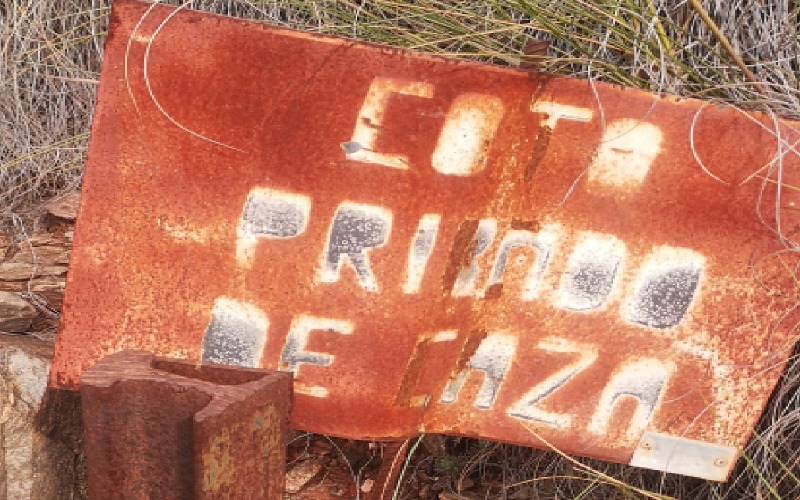- Walking
- WalkTallSpain Videos
- WalkTall Group
- Physical & Mental Benefits of Walking
- What are the benefits of using Wikiloc i...
- When is it too hot to walk in Spain?
- Walk With Purpose and Raise Funds with t...
- How to keep cool walking in Spain
- Walking Routes
- WalkTallSpain Merch
- PELIGRO Dangers of Walking & Hunting
- More articles here »
- Writing
- Spain
- Therapies
- Partnership Hub
PELIGRO Dangers of Walking & Hunting
PELIGRO - DANGER! - Walking through the Spanish countryside is very pleasurable and calming, allowing us to connect with nature, rejuvenate our minds, and stay physically active. However, the presence of hunters in the same serene spaces can pose significant risks. And you do need to be aware of them when hiking. Understanding the dangers of hunting seasons and implementing safety measures can ensure your walks remain both enjoyable and safe. We may not like hunting, but sometimes there are controls in place to avoid the pests that are deemed dangerous to people, or harmful to agriculture and other animals.
Walking Safely During Hunting Season...or even out of it!
How bad could it be? Across the world, tragic events DO happen, and highlight the need for better awareness and precautionary measures.
- Mistaken Identity: Walkers may be mistaken for game, especially in low-light conditions or dense foliage. Hunters might not always have a clear view, leading to potential misidentifications.
- Stray Bullets: Bullets or arrows can travel significant distances and might hit unintended targets, including walkers.
- Shared Trails: Many walking trails overlap with hunting areas, increasing the likelihood of encountering hunters.
It can be really unsettling when you suddenly hear a shot ringing out
Tips for Walkers To Remain Safe During Hunting Seasons
- Know the Seasons and Areas: Familiarise yourself with the local hunting seasons and designated hunting zones. This information is typically available through the local town halls or online.
- Wear High-Visibility Clothing: Wear bright, fluorescent colours such as orange, yellow, or pink. High-visibility clothing makes you stand out against the natural backdrop, reducing the risk of being mistaken for game. Avoid earth-toned or animal-coloured clothing.
- Use a Walking Stick... with a Flag: If you use walking sticks, consider attaching a brightly coloured flag to it. This added visibility can alert hunters to your presence from a distance.
- Stay on Marked Trails: Where possible, stick to well-trodden / marked paths. Hunters are more likely to expect people on these routes and exercise extra caution.
- Make Noise: Whistle, sing, or engage in conversation if walking with others. Noise alerts hunters to your presence, preventing surprise encounters.
- Dawn and Dusk: Hunters are most active during the early morning and late evening hours when game is more active, and the temperature is cooler, however that is when most of us walkers are out. You may not be able to avoid those times of day, but if you are out then, please be extra cautious.
- Leash Your Pets: All dogs in Spain are required to be on the lead in public places. I know that not everyone does. But PLEASE keep pets on a leash and close to you. Like humans, pets can be mistaken for game, especially if they are roaming freely.
- Tell someone of your route: Let a friend or family member know your walking route and expected return time. This practice ensures someone is aware of your whereabouts in case of an emergency. Consider using an App to show your live location, so your loved one knows where you are at all times.
Signs and their Meanings in the Spanish Countryside
- BLACK AND WHITE DIAGONAL: This is a common sign in the campos. This sign means you are entering a hunting area.
- COTO DEPORTIVO DE CAZA: The area is reserved for the sport of hunting. Showing that hunting is allowed in those areas during season.
- COTO DE PRIVADO DE CAZA: Same as the Black and White Diagonal, just written out. It's a hunting area. The owner of the land has the right to hunt there
- ZONA DE RESERVA or a RED SQUARE SIGN: No hunting allowed beyond that point. No guns as there is risk to others.
- PELIGRO ACCION DE CAZA: Avoid this area as this is where hunting is CURRENTLY active.
- PELIGRO CACERIA JABALI: Danger of wild boar hunting in the area.
Not hunting related but useful to know
- PELIGRO ABEJAS which indicates that there are beehives nearby and to be cautious.
- ZONA INUNDABLE which shows where an area is likely to flood
Walking is a cherished activity that should not be overshadowed by the dangers of hunting season. By staying informed and taking proactive safety measures, you can continue to enjoy the beauty and tranquillity of nature without undue risk. Always prioritise your safety and the safety of others by remaining vigilant and prepared during your outdoor adventures.... and be prepared to walk back the way you came!!!!
If you would like to know more about CAZA HUNTING then please visit the practical information provided on JuntaDeAndalucia website
Where Could The Hunters Be?
Hunters must respect a security zone. This is supposed to be a minimum of 250 meters in all directions from a property. There are meant to be safe zones near roads, camino´s, ramblas, railways and I believe rivers and streams too. So there SHOULDN'T be a hunter there, let alone aiming in those areas.When is the Hunting Season?
Your guess is as good as mine! Just when I think we are out of hunting season, I hear a shot ring out!! Here is a table of some of the information I have gleamed. This is ONLY A GUUIDE. Some areas have different rules and regulationsThe hunting season seems to span from July to April for various species. The earliest hunting season starts in July for roe deer, followed by rabbits and burrow dogs in August, with the latest hunting season extending until April for mountain goats. Throughout the period, different species such as quail, pigeons, corvids, wood pigeons, zurita, rock pigeons, thrushes, spotted starlings, red partridge, hare, quail, and other small game are permitted to be hunted, with specific seasons allocated within this timeframe.....Large game like deer, fallow deer, and wild boar can be hunted from October to February.
While hunting is a regulated activity with its own safety protocols, it's essential that we all work together to remain safe.
Do you have any more hints and tips and information to share with us? Have you any amendments to suggest? Please comment below...
Previous comments
Hayley Crowley
"Really good read and really informative, handy to know. "
Leave a comment about this article.
Please only enter text (up to 1500 characters) and no symbols.



.jpg)
